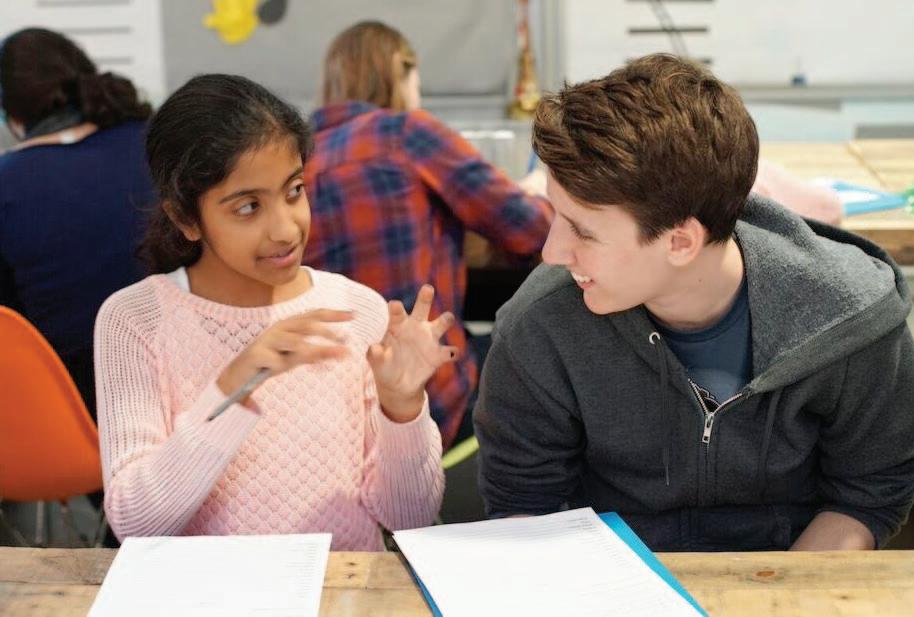
6 minute read
people and places
A revolution in education
Khan Academy was launched in 2006 with a bold mission: to provide a free world-class education for anyone, anywhere. With millions of learners across the world studying online at their own pace and in their own language, Khan Academy has become the epitome of the global classroom. Following this success, Khan Academy founder Sal Khan has set his sights even higher. The launch of a small experimental research school in California marks the beginning of a new project through which Khan hopes to stimulate a paradigm shift in education towards student-centred learning. This article outlines how the Khan Lab School is pioneering a revolutionary approach to education. Currently catering for children aged 5-14 years, the school plans to open a high school in 2017.
Self-paced and mastery-based
At the Khan Lab School, a customised learning experience has been created whereby each student identifies his/her unique needs and sets goals that determine the school work they undertake. As one would expect from the creators of Khan Academy, much of the academic learning begins with technology: students watch videos and take formative and summative assessments using responsive online tools. This is underpinned by weekly one-on-one conferences and small group seminars with teachers that support personalised learning, remedy misconceptions and set goals for the future.
Unlike most schools, in which teachers have a set amount of time to cover a topic, students at the Khan Lab School can take as long as they need to master content and skills before moving on. As one 12 year old student explains, “If I don’t think I’m ready, I can schedule [the topic] for a later time. I can make sure I learn the subject fully, not just part of it.” Dominic Liechti, Executive Director and President of the Khan Lab School, emphasises that maximizing positive and impactful relationships between students and teachers is key to the success of this model: “Independence is important, but appropriate guidance within a cohesive structure is also very important. One of our learning design principles is to foster student agency [whereby] the teacher acknowledges the student’s ownership of learning and trusts the student to disclose challenges that are resolved ultimately by various inquiry-based approaches and modes.”
It is through this approach that students achieve fluency in reading, writing, maths, computing and a foreign language,
as well as learning in wellness, the arts, civics, the sciences, finance, global societies, economics and statistics. Liechti describes how the academic curriculum was derived: “We started by looking at what concepts we would like to expose our kids to, starting with conflict, relationships, culture and identity, as well as the skills the workforce is demanding as we move from an industrial age to a conceptual age. There’s no question about learning basic skills like reading and writing, but equally there is no need for memorisation.”
Architecture for learning
The Khan Lab School consists of one large room with several smaller breakout rooms attached, allowing students of all ages to learn and collaborate together. Mikki McMillion, Lead Teacher, describes the advantage of this design: “As a teacher, it is a wonderful learning and growth environment. I have gained a much wider perspective of student learning as I get to view the learning that happens from 5 to 14 years old. The most beautiful moments are when all the ages are together – the atmosphere feels like a family.”
That said, there are some challenges that come with an open classroom environment, as one student explains: “It can be easy to get distracted when other people are being loud, but if you want peace and quiet, you can go to a breakout room.” The breakout rooms provide a space for students to work independently or in small groups. Groupings are informed by independence level, as opposed to age or academic ability, and this is measured using a rubric that describes a student’s independence path from early childhood to a career-ready young adult. The area of “focus”, for example, begins with staying engaged in a playful activity and culminates in the ability to recognise and get into a

flow state, during which the student is fully immersed in an intrinsically rewarding activity
Project-based learning
The school aims for students to spend about half their time learning through projects in order to apply content to meaningful real-life and unfamiliar contexts. Some recent examples include designing and making a snowboard, creating a business selling handmade cards and crafts, teaching Arabic to younger children, and teaching underprivileged children how to cook a healthy meal for their families. Other projects are linked to external activities which capture the students’ interests. For example, one student took part in the National Novel Writing Month, setting herself a writing goal of 20,000 words and thus developing both her writing and time management skills. Students exhibit their project work to a public audience several times a year and receive feedback from experts in the fields. One student tells of how she presented a children’s book she had written, and asked the public for donations to pay for illustrations and publishing. After selling the book for a profit, she donated the proceeds to the Worldwide Fund for Nature (WWF).
Without grades or transcripts, the culmination of a Khan Lab School education will be the production of a graduate portfolio: a compilation of a student’s work which displays mastery across academic and non-academic domains. The school is piloting existing portfolio models to decide how best to display and communicate student work in preparation for the high school opening in 2017. Career and College Director, Erica Cosgrove, envisages that the portfolio will incorporate a range of media, including “a video component where you can see students work in real time and they can talk about
their projects; links to websites they have created; reflections and feedback on their conceptual understanding and competencies; challenges and opportunities; photographs and examples of creations and artifacts; and a log of their internships, volunteering and work experiences”.
Sharing success
The Khan Lab School is a small venture with gigantic ambitions. Can it succeed in catalysing a paradigm shift in education? By starting small, Sal Khan hopes to develop and hone an educational model that is empathetic to the needs of students, educators and administrators. Over time, the curriculum, resources and best practices will be made available for use by educational institutions around the world. As Khan explains, “In 10 or 15 years, any student on the planet will be able to get a smartphone and self-educate; Khan Academy can be the resource that liberates the classroom to focus more on experiential learning. We are in start-up mode right now [at the Khan Lab School], but over time the goal is that the Lab School itself will be a replicable model and the facets of the school will be useable by schools in different ways”. Khan wants to bring together the successes of Khan Academy and the educational model of the Khan Lab School to empower educators everywhere to create truly student-centred classrooms.
Leila Holmyard is a curriculum consultant and freelance education writer based in Frankfurt, Germany. Email: leilaholmyard@gmail.com
For further information about the Khan Lab School and Khan Academy, see www.khanlabschool.org www.khanacademy.org












